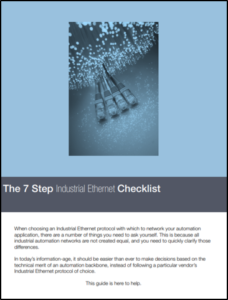In the previous article about HMIs we mentioned what an HMI was. Next, in this article, we are going to show how they are typically used in a PROFINET HMI context. Often, the decision on which protocol to use on the HMI(s) depends on your application requirements and what protocol drivers the HMI supports. So let’s take a look at the main differences between TCP/IP protocol based HMIs and PROFINET HMIs.
Most HMIs are not time critical (TCP is OK)
As mentioned, a HMI is for use by a human operator to interface to a machine. In typical applications this is not time critical as most HMIs monitoring the process will update in some seconds or hundreds of milliseconds and the data packets used are typically larger, therefore a TCP based protocol is used. Usually there is also a lot of data being exchanged, so TCP/IP also makes sense to be able and send thousands of bytes. And this timing is fine with the operator of the HMI as they will not notice a difference between a second or 500ms when viewing some HMI screens or changing values.
PROFINET can make your HMI real time
However, sometimes you might need some real time control from an HMI and more precision for certain applications. For example, in the case of a HMI helping control the process with push buttons, e-stop or to issue certain time critical commands (real time operator input, LED output) this requires real time control and a protocol like PROFINET. The PROFINET protocol can carry time critical information from IO devices in the plant such as an IO block, valve, variable frequency drives, or other types of devices. Most of the time, the PROFINET messages are small because we are typically talking bits and bytes with the IO devices to turn something on or off. In the event we want the HMI to communicate PROFINET, it would act as an IO device and send inputs to the controller (PLC/PAC/DCS) application in real time as well as receive outputs from the controller.
HMIs can support multiple protocols
Some HMIs can also speak multiple protocols. If PROFINET is supported, you could opt to have non real time (TCP) and real time (PROFINET) communications setup to a HMI simultaneously. That is a big advantage of using HMIs with PROFINET due to its added real time (RT) functionality. It should be stated that PROFINET is also an open Industrial Ethernet network where you can have HMIs, PROFINET IO devices, and standard TCP/IP based devices on the same network without issues. As TCP based HMIs can add a lot of traffic, be sure to check the PROFINET design guidelines when designing your system if you have some of those.
HMI Metrics and comparison of PROFINET and TCP/IP protocols
Below you can see a table of the main differences when using a PROFINET IO device driver in your HMI versus a typical TCP/IP based HMI to help in your decision on which one to use for your application(s).
| HMI Metrics | PROFINET IO device protocol | TCP/IP protocol |
|---|---|---|
| Data size | Up to 1440 bytes input and output | Could be thousands of bytes (64kb) |
| Update time | 1 to 10 milliseconds typical | 100+ms typical |
| Protocol | PROFINET real-time (RT) | vendor specific Siemens S7 HMI, GE HMI, Phoenix Contact HMI), OPC-UA, and many others (also acyclic PROFINET functions) |
| Access to PLC memory areas | Indirect access to PLC memory through IO address buffers (likely requires additional PLC programming to move data) | Direct access to PLC memory or indirect (less common) |
| Timing accuracy | Time critical / real-time | Not time critical |
| OSI model network layers for transporting HMI data | Layer 2 (Ethernet) | Layer 4 (TCP) |
In conclusion, most applications will use some form of TCP/IP based HMI protocols on your system, and normally that is fine. However, remember that PROFINET offers real time and other features that can make your HMI even faster when needed. You can also check out what HMIs are available for PROFINET using the online PI Product finder and the HMI filter. But be sure to ask which protocols are supported on the HMI and if multiple protocols are possible when considering your HMI vendor. Finally, double check if it will meet your application needs and design your network properly. If you want to learn more about how PROFINET works, attend one of our upcoming training classes.
